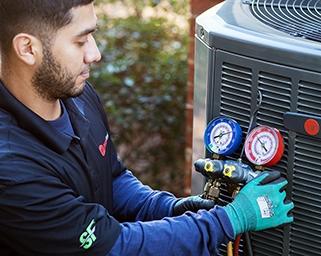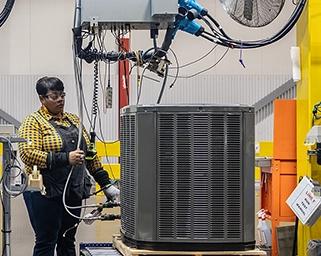Is R-22 Refrigerant Available, and What Does R-22 Cost?
Learn about the scarcity of R-22 (Freon®), when new imports were banned, where you can find it, and why now might be a good time to upgrade your aging HVAC system.
By Anne Fonda
R-22 refrigerant, commonly known by the brand name Freon®, is an older refrigerant used in air conditioning systems and heat pump systems manufactured before 2010.
Why was R-22 banned?
R-22 refrigerant has a high global warming potential (GWP) and depletes the Earth’s ozone layer, which contributes to climate change. Because of this, the U.S. began phasing it out in 2010. Through the Montreal Protocol on Substances that Deplete the Ozone Layer, the United States committed to a collaborative, international effort to regulate and phase out ozone-depleting substances (ODPs).
When was R-22 banned?
The phaseout started in 2010, when the U.S. stopped the sale of newly manufactured residential cooling systems that use R-22.
The U.S. Environmental Protection Agency (EPA) banned the production and import of R-22 on January 1, 2020. But existing equipment manufactured before 2010 still uses R-22. Its use will eventually be eliminated in the U.S., so homeowners need to be prepared for the transition.
Where can I buy R-22?
Because of environmental regulations, you cannot buy R-22, but an HVAC company can purchase R-22. It’s getting harder to find R-22 refrigerant for sale, but some HVAC supply houses and online stores have a limited amount that has been recovered, recycled, and reclaimed from retired units.
Be sure your HVAC company has a reputable refrigerant supplier. Several people face federal charges for illegally importing R-22 from China and Mexico with the intent of selling it on the black market.
How much is R-22 per pound?
R-22 refrigerant cost is based on the price per pound. If your older AC unit or heat pump needs a refrigerant recharge, it may need 2-4 pounds per ton of capacity for a complete recharge.
In 2025, the average price per pound is $150, but can range from $90-$250 per pound. If you need a full recharge on a 5-ton system, that could cost you as much as $1,250, not including the service call fee and any other needed parts or repairs.
What is the replacement for R-22 refrigerant?
The original R-22 replacement refrigerant was R-410A refrigerant, but that is being phased out as well. Newly manufactured air conditioners and heat pumps are designed to use R-454B refrigerant, which has a 78% lower GWP than R-410A.
Can I use a newer refrigerant if my AC system uses R-22?
No. You cannot mix and match HVAC refrigerants. HVAC equipment is manufactured to use one type of refrigerant. Using a different refrigerant would damage the system. It’s also unsafe and illegal.
Should I replace my R-22 system?
Yes. Start planning now. Any HVAC system that uses R-22 refrigerant is at least 16 years old as of this writing, since the last units using R-22 were manufactured in 2009 or earlier. The average lifespan of an air conditioner or a heat pump is 15 years.
While age is not the only determining factor for replacing an HVAC system, the high cost of R-22 and the decreasing energy efficiency that comes with an aging system make a newer, more efficient system that uses a more sustainable refrigerant an attractive option.
“My advice to anyone who may have an aging system that requires frequent repairs is to consider replacing the whole system versus just one component. Typically, with an older system, the technology has become obsolete, and new parts are not completely compatible with older systems.”
-Kimberly Sexton, Senior Systems Engineer, Trane Technologies
Learn more about HVAC replacement
Replacing your HVAC system is a big decision. We’ve pulled together a library of articles for you to read to help you decide if the time is right and what you might want to consider.
- HVAC Replacement: A Homeowner’s Guide
- 5 Warning Signs It’s Time for Furnace Replacement
- Top Warning Signs It’s Time for Heat Pump Replacement
- 4 Warning Signs It’s Time for AC Replacement
- Furnace Replacement: A Buying Guide
- Heat Pump Replacement: A Buying Guide
- AC Replacement: A Buying Guide
- Hybrid Heat Systems: How Do They Work?
Work with the HVAC sustainability experts
At Trane, we’re committed to helping homeowners like you reduce your energy consumption and save money with energy-efficient HVAC systems. We can also help you reduce your carbon footprint with a heat pump system.
Contact your local Trane dealer(s) to discuss your options and find the HVAC system that’s right for your home.
Anne Fonda, Content Writer
A Content Writer with Trane Technologies, Anne Fonda researches topics and writes for Trane® and associated residential HVAC brands. She works in collaboration with Trane Technologies subject matter experts, offering easy-to-understand, informative content on complex topics. Her goal is to help consumers make informed decisions on the products and services they need.
She has written for HVAC and other service provider websites for over 16 years. Before transitioning to web content writing, Anne had a 14-year stint as an award-winning journalist. She graduated cum laude from the University of Missouri-Columbia School of Journalism.
When she’s not working, Anne enjoys playing word games, reading, gardening, spending time with family, and visiting gardens and museums.
Expert review by Kimberly Sexton, Senior Systems Engineer




